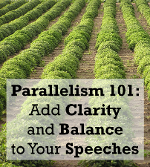| Home » Articles » Speech Writing |
One of the most important writing techniques I ever learned was parallelism. Parallelism leads to clear writing, and clear writing leads to clear speaking. In this article, we define parallelism, study numerous examples, and discuss how you can incorporate it into your speeches.
What is Parallelism?Parallelism is the successive use of identical grammatical patterns of words, phrases, or sentences. Sound boring? Wait — don’t give up yet! Parallelism may involve repetition of some words, but more generally involves repetition of parts of speech (e.g. nouns, verbs, adjectives). It is sometimes referred to as parallel structure or parallel construction. Examples of ParallelismConsider two examples from Abraham Lincoln’s Gettysburg Address, both of which involve some repetition of individual words. In the first, the parallel pattern is “[preposition] the people”. In the second, the parallel pattern is “we can not [verb]”.
Feel the “[verb] any [noun]” parallel pattern repeated in John F. Kennedy’s Inaugural address:
For a more contemporary example, consider Steve Jobs’ 2005 Stanford Commencement Address:
The parallel pattern here is a little longer: “that my [noun — related to me] had never graduated from [noun — educational level]” Benefits of ParallelismFrequent effective use of parallelism is essential for clear writing. Don’t believe me? Stroll through a sample of writing in any newspaper, magazine, textbook, or novel and you are sure to trip over numerous examples of parallelism. Speechwriting is no exception. Every speech benefits from the use of parallel structure. These benefits include:
How to Use Parallelism in Your Speeches1. Use parallelism to emphasize a comparison or contrast.Consider Neil Armstrong’s famous line spoken from the moon on July 20, 1969:
Note the contrast between “small step” and “giant leap”; and between “man” and “mankind”. This form of parallelism even has a fancy name: syncrisis. For a less grand example, study Henry Ford’s off-the-mark comments about exercise:
Note the use of contrasting terms (“healthy”, “sick”) in parallel structure. Finally, consider this hypothetical example from a political debate which uses parallel structure to magnify the contrast between opposing ideologies:
2. Use parallel structure for lists of words or phrases.For example, note the repeated parallel structure “[verb] the [noun]”
3. End parallel words or phrases with same letter combinations.For example:
With this “[past tense verb] [adverb]” parallel pattern, each phrase ends in “-ly”. This partial rhyme creates a balanced, rhythmic sound. This form of parallelism also has a fancy name: homoioteleuton. (Don’t worry… I don’t remember that name either.) 4. Combine parallelism with the power of 3.While you only need two elements to create parallel structures, there’s something magical about three parallel elements. Read more in How to Use the Rule of Three in Your Speeches. Once you’ve mastered the parallel triad, consider intentionally breaking the pattern in the last element for a powerful or comedic effect. This is described in How to Add Power or Humor with the Rule of Three. 5. Use parallelism on your slides and handouts.Just as parallelism benefits your spoken words, it also benefits your printed words. Your slides and handouts (when used) are an important presentation element; don’t neglect them. In particular, check your bulleted lists to make sure that you’ve used parallelism correctly. Caution! Don’t make your slides too wordy; audiences hate being read to. But if you must have text, consider using parallel structure. 6. Use pauses and vocal variety to “mark” parallel structures.No matter how well a speech is written, a speaker who delivers it in a flat, monotone voice will ruin it. Don’t be that speaker! Use pauses and vocal variety to help convey the start or end of the parallel patterns. Your audience can’t “see” your commas (or any other punctuation) to know where the parallel structures are divided, so you have to convey them vocally. Give it a Try!You may already be using parallelism without knowing it, but we can all improve our speech writing. Share your examples of parallel structure in the article comments. | |
| Views: 415 | |
| Total comments: 0 | |
